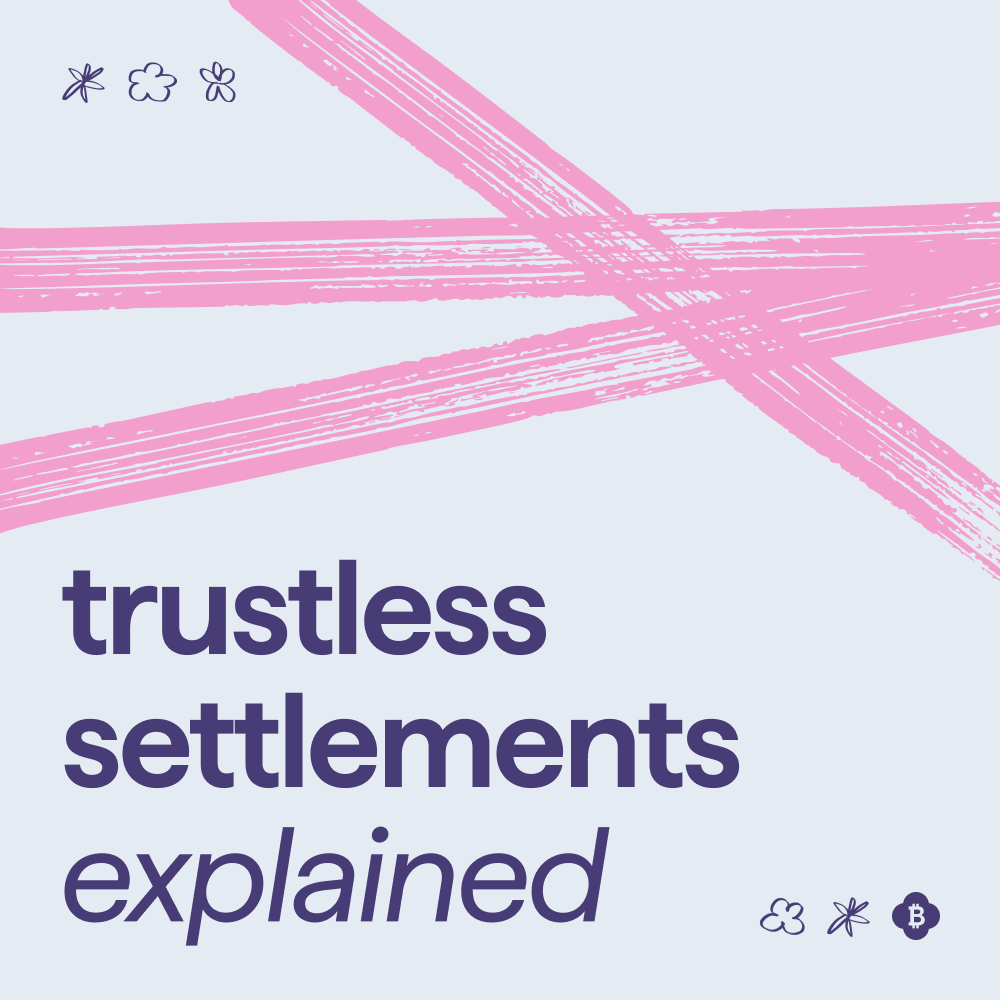
What is Trustless Settlement?
Technical
1 July, 2025

In a world where "trust but verify" has become "don't trust, verify," trustless settlement represents the holy grail of cross chain swaps. It's the difference between hoping someone keeps their word and knowing mathematically that they have to.
Trustless settlement represents a paradigm shift from trust-based to cryptographically secured cross-chain interoperability. Unlike traditional cross chain bridges that rely on validator sets or custodial mechanisms, trustless systems leverage mathematical proofs and smart contract primitives to guarantee atomic execution.
In the context of Bitcoin bridge infrastructure, trustless settlement eliminates the fundamental trade-off between security and efficiency that has plagued cross-chain protocols since their inception.
Custody Problem in Cross-Chain Infrastructure
Traditional cross chain bridge architectures typically implement one of several trust models:
According to Chainlink’s Seven Key Cross-Chain Bridge Vulnerabilities Report, traditional bridge vulnerabilities resulted in over $2.8 billion in losses, representing 40% of the total value hacked in web3, primarily due to compromised validator sets and smart contract exploits.
Theoretical Foundations of Trustless Settlement
Trustless settlement protocols derive their security guarantees from several cryptographic primitives:
Atomic Swaps: Originally formalized in the Bitcoin Lightning Network whitepaper, atomic swaps ensure transaction atomicity through cryptographic linking across disparate blockchain networks.
Hash Time Locked Contracts (HTLCs): These conditional payment mechanisms implement both hashlock and timelock constraints, as detailed in BIP 199. HTLCs provide the fundamental building blocks for trustless cross-chain protocols.
Zero-Knowledge Proofs: Advanced implementations leverage zk-SNARKs and zk-STARKs to enable privacy-preserving settlement verification, as demonstrated in protocols like Aztec's cross-chain infrastructure.
Technical Architecture: Protocol Specification
Trustless cross chain swaps follow a four-phase execution model with cryptographic safety guarantees:
Phase 1: Commitment and Preimage Generation
Technical Implementation:
- Initiator generates cryptographic preimage P and computes hash H = SHA256(P)
- Counterparty verifies swap parameters and agrees to hash commitment
- Both parties deploy HTLCs on respective chains with identical hash requirements
HTLC Parameters:
- Hash Function: SHA-256
- Timelock Duration: T1 (source chain), T2 (destination chain) where T1 > T2
- Asset Amount: Specified in the respective chain's native denomination
- Recipient Address: Cross-chain verified public key
Phase 2: Bilateral Fund Commitment
Protocol Execution:
- Initiator deposits Asset A into HTLC_source(H, T1, Counterparty_Address)
- Counterparty deposits Asset B into HTLC_dest(H, T2, Initiator_Address)
- Both transactions achieve finality per respective chain's consensus mechanisms
Phase 3: Atomic Revelation and Claiming
Cryptographic Execution:
- Initiator reveals preimage P to claim Asset B from HTLC_destination
- Blockchain records the preimage in transaction data, making it publicly observable
- Counterparty extracts P from blockchain state and claims Asset A from HTLC_source
- Both claims must occur within respective timelock windows
Phase 4: Settlement Finalization or Timeout Recovery
Termination Conditions:
- Success State: Both parties successfully claim counterparty assets
- Timeout State: Timelocks expire, funds automatically return to original depositors
- Partial Failure: Only one party claims; remaining funds subject to timeout recovery
According to research published in the Journal of Cryptographic Engineering, HTLC-based protocols demonstrate 99.97% success rates in live network conditions when properly parameterized for network latency and confirmation requirements.
Implementation Challenges and Solutions
Clock Synchronization: Cross-chain timelock coordination requires careful calibration for network-specific block times and confirmation latencies.
Liquidity Provisioning: Market maker networks address the bilateral matching problem through automated liquidity provision, implementing sophisticated non-custodial bitcoin bridge mechanisms.
MEV Considerations: Front-running and sandwich attacks on atomic swap transactions require careful transaction ordering and privacy measures.
Garden's Implementation
Garden implements a production-grade trustless settlement system optimized for fast Bitcoin bridge operations. The protocol architecture enables cross chain swaps in under 30 seconds through several innovations:
Market Maker Network: Professional liquidity providers maintain HTLC-ready positions across supported chains, enabling immediate swap execution without peer-to-peer matching delays.
Intent-Based Architecture: Users specify desired outcomes rather than execution paths, allowing the protocol to optimize routing and minimize settlement times.
Bilateral Vault System: Cryptographically-linked vault contracts ensure atomic settlement across Bitcoin and 10+ EVM-compatible chains, maintaining full non-custodial guarantees.
Garden's approach demonstrates that trustless cross chain bridges can achieve both institutional grade security and consumer friendly user experiences without fundamental trade-offs.
Future Developments
ZK-Rollup Integration: Cross-chain settlement within zero-knowledge environments promises enhanced privacy and scalability.
Interoperability Standards: Protocols like IBC and Cosmos' Inter-Blockchain Communication standard are establishing formal specifications for trustless cross-chain messaging.
Conclusion
Trustless settlement represents the maturation of cross-chain infrastructure from experimental protocols to production deployed systems. As the multi-chain ecosystem evolves, mathematical guarantees will increasingly replace trust assumptions in Bitcoin bridge and broader cross-chain applications.
The transition from "don't trust, verify" to "don't trust, prove" marks a fundamental evolution in how decentralized systems handle value transfer across blockchain boundaries.
About Garden
Garden is the fastest Bitcoin bridge, enabling cross-chain Bitcoin swaps in as little as 30 seconds. It is built using an intents-based architecture with trustless settlements, ensuring zero custody risk for users.
Join the Garden townhall and ask our expert gardeners about soil acidity and trimming bushes.
Last updated 1 days ago